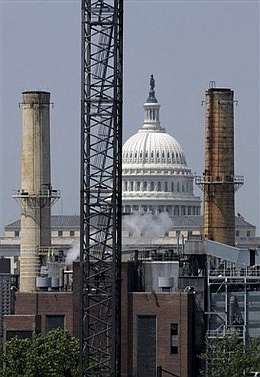The U.S. coal-fired power plant fleet is filled with geezers. Out of 1,522 existing generating units, 600 were running during the Nixon-Kennedy debates. Nearly 10 percent were built in the 1920s, 1930s, and 1940s.
 Still, it would be hard to find a coal plant that has seen more history than the Capitol Power Plant in Washington, D.C. It was commissioned by an act of Congress in 1904 and completed in 1910. That year, Teddy Roosevelt was the first U.S. President to ride in an airplane. The plant was eight years old when the doughboys came home from France. When it was ten, women won the right to vote.
Still, it would be hard to find a coal plant that has seen more history than the Capitol Power Plant in Washington, D.C. It was commissioned by an act of Congress in 1904 and completed in 1910. That year, Teddy Roosevelt was the first U.S. President to ride in an airplane. The plant was eight years old when the doughboys came home from France. When it was ten, women won the right to vote.
You get the picture: this is one geriatric coal plant.
But don’t mistake aged for feeble. Though the Capitol Power Plant hasn’t produced a watt of electricity since 1952 — just steam and refrigeration for the Capitol Complex — the old horse still delivers a chest-crunching, asthma-inducing kick, literally killing people in surrounding neighborhoods. A 2004 study by the Clean Air Task (PDF) estimated that 515 people die annually in the D.C. metropolitan area due to power plant emissions — fifth among all cities. In 2002, the Capitol Power Plant was responsible for 65 percent of the PM2.5 particulate pollution produced by all point sources in the District of Columbia. The consequent toll of premature deaths falls disproportionately on an impoverished, largely African American population.
With leadership from the Capitol architect and Nancy Pelosi, the House of Representatives last year initiated an effort to replace coal with natural gas for the portion of the Capitol Power Plant that serves the House of Representatives.
On the Senate side, things don’t look as good. Since 2000, two Senate leaders, Mitch McConnell (R-Va.) and Robert Byrd (D-WV), with a combined tenure of 73 years, have blocked the Senate from eliminating coal at the plant. In May 2007, CNN reported that two companies, International Resources Inc. and the Kanawha Eagle mine, have a contract to supply a combined 40,000 tons of coal to the plant over the next two years. The companies gave $26,300 to the McConnell and Byrd campaigns during the 2006 election cycle.
When you combine the death toll, the dirty money, and the climate impacts, you’ve got a pretty good microcosm of what’s wrong with U.S. coal policy.
Fortunately, PowerShift is bringing 10,000 young climate activists to D.C. in late February, and people are fired up for action. Organizers from over 20 groups are making plans for what looks to be the largest single protest against coal in the nation’s history, a peaceful sit-in scheduled for March 2 at the Capitol Power Plant.
Matt Leonard of Greenpeace, one of the organizers, writes:
We aim to create an action framework that is accessible to all — from students, to elderly, to parents, to notable public figures and beyond. We envision a structured event that includes agreed-upon action guidelines, extensive training on non-violence, and a respectful tone that participants would be asked to abide by. We will have a legal team organized to support participants and will have prior discussion with authorities as to our non-violent intentions.
Around the world, direct action protests against coal have risen dramatically in the past year. A partial list compiled on the CoalSwarm wiki shows 11 such actions from 2004-2006, 17 in 2007, and 42 so far in 2008.
Several prominent individuals, including Nobel Prize winner Al Gore, NASA climate director James Hansen, author Wendell Berry, and NRDC cofounder Gus Speth, have argued that the climate crisis has reached such a level of urgency that non-violent direct action is now called for. In September, Hansen traveled to England to testify at the trial of the "Kingsnorth Six,” all of whom won acquittal.
On the website for the action, the organizers write:
We can determine the fate of our generation. We know there is a climate crisis and we know we have to stop it. We’ve organized, we’ve lobbied, we’ve passed policies, we’ve educated, we’ve agitated, and still our government has not recognized the scope and urgency of global warming. We know we have the capacity to transform our society. What we lack is the political will.
But now there is a new administration and a new Congress, which gives us another chance. We have a window, but we must open it. Together.
Like the movements that have come before us, we have an opportunity to send a powerful message of urgency through peaceful civil disobedience. There has never been an American tradition more noble, and it is needed now more than ever.
Details on the Capitol Power Plant protest can be found here.

